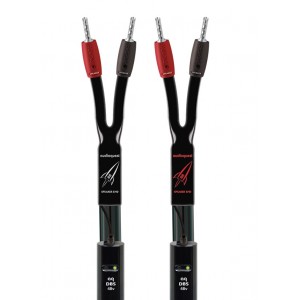Rocket 88 incorporates AudioQuest’s patented Dielectric-Bias System (DBS) and replaces Long-Grain Copper with solid Perfect-Surface Copper+. DBS offers a lower noise-floor, so you can hear deeper into the nuances of your favorite music. At the same time the addition of more PSC+ offers a smoother, more relaxed, and natural sonic timbre and texture.
SOLID PERFECT-SURFACE COPPER+ (PSC+) CONDUCTORS: Rocket 88 uses a carefully finessed, optimized and extremely high-purity Perfect-Surface Copper+. The astonishingly smooth and pure combination of PSC+ significantly eliminates harshness and greatly increases clarity. Rocket 88’s conductor mix is PSC+.
CARBON-BASED NOISE-DISSIPATION and CROSS-TALK-DISSIPAITON SYSTEMS (INSULATION): The four negative conductors in Rocket 88 are insulated with partially conductive Carbon-Loaded Polyethylene. This remarkable material damps radio-frequency garbage from being fed back into the amplifier. The sonic benefit is exactly the same reduction in “hash” and better dimensionality that comes whenever RF garbage is reduced in an audio circuit. Rocket 88 uses Nitrogen-Injected Foamed-Polyethylene Insulation on its positive conductors because air absorbs next to no energy, and Polyethylene is low-loss with a benign distortion profile. Thanks to all the air in Foamed-Polyethylene Insulation, it causes much less of the “out-of-focus” effect common to other materials.
DIELECTRIC-BIAS SYSTEM (DBS): All insulation slows down the signal on the conductor inside. When insulation is unbiased, it slows down parts of the signal differently, a big problem for very time-sensitive multi-octave audio. AudioQuest’s DBS creates a strong, stable electrostatic field which saturates and polarizes (organizes) the molecules of the insulation. This minimizes both energy storage in the insulation and the multiple nonlinear time-delays that occur. Sound appears from a surprisingly black background with unexpected detail and dynamic contrast. The DBS battery packs will last for years. A test button and LED allow for the occasional battery check.
DOUBLE STAR-QUAD GEOMETRY: The relationship between conductors defines a cable’s most basic electrical values (capacitance and inductance). However, even when those variables are kept in a reasonable balance, the relationship between conductors can be varied in ways that greatly affect the sound. The Double Star-Quad construction of Rocket 88 allows for significantly better dynamic contrast and information intelligibility than if the same conductors were run in parallel.
SPREAD-SPECTRUM TECHNOLOGY (SST): Any single size or shape of conductor has a specific distortion profile. Even though radially symmetrical conductors (solid or tubular) have the fewest discontinuities, any conductor of a particular size does have a sonic signature. SST is a method for significantly reducing the awareness of these character flaws by using a precise combination of different sized conductors. The different SST-determined conductor sizes used in Rocket 88 allow an exceptionally clear, clean and dynamic sound.
BIWIRING: Rocket 88 is an exceptional Single-BiWire cable. When the halves are separated at the speaker end, the Double Star-Quad Geometry turns Rocket 88 into a true Double-BiWire set thanks to the magnetic autonomy of each Quad-conductor section. On its own, one Star-Quad conductor group would be a little lightweight in performance as it is biased towards treble finesse. The other Star-Quad conductor group is biased toward the bass; it’s more forceful and lacking ultimate resolution. Together they form a completely optimized full-range design. When separated, the Double Star-Quad design allows Rocket 88 to be a maximum-performance Double BiWire in a single cable.
TERMINATIONS: AudioQuest offers a wide range of high-quality connectors that allow Rocket 88 to be securely attached to any type of equipment. Quality is in the low-distortion sound, not necessarily in the eye-candy effect. AQ ends are either dull looking gold or silver because these metals are plated directly over the connector. There is no shiny and harsh sounding nickel layer underneath. AQ PK-spade lugs are soft because better metal is soft, and facilitates a higher quality connection. For pieces requiring a banana plug or BFA connector the AQ PK-BFA/Banana provides unprecedented performance over conventional brass versions.
APPLICATION: The PVC “pants” on either end of Rocket 88 are marked “Speaker End” or “Amp End.” Please use cables in the direction required.
Difficile de faire un choix parmi tant de référence et de marques aujourd'hui, le marché du câble enceintes est tellement large avec des fabricants provenant des quatre coins du monde.
Vous êtes nombreux à nous raconter votre premier achat de câble enceintes comme un accident malheureux, votre écoute est devenue fatiguante et au bout de 30 minutes vous subissez l'écoute davantage que vous n'en profitez. Le haut du spectre s'emballe et se projette, ou bien le grave est bien trop coloré, la scène sonore est étouffée, les instruments sont perdus dans la masse, la voix n'est pas détachée..
Bien souvent, le mariage des câbles enceintes avec votre matériel ne convient pas... Votre câble est peut-être excellent, mais il est excellent avec d'autres enceintes ou d'autres électroniques.
L'équipe de Cables-Hifi.fr va vous livrer quelques astuces pour vous aider lors de prochain achat :
De nos jours, des théories dites 'scientifique' ou même 'physique' vous préconise un câble avec une section importante car selon ces théories plus la section est importante, meilleur est la restitution sonore. (Principe du plus gros, plus fort..).
Il faut tout de même noter que ces théories sont créés par des personnes qui ne sont pas dans le domaine audio, et qui n'écoute pas...
Ces théories sont absolument fausses , et nous avons pu le constater à maintes et maintes reprises !
Des câbles de petites sections tel que du Albedo Blue HP peuvent être bien plus agréable à l'écoute qu'un câble avec une grosse section.
Assez fréquemment, nous vous parlons de mariage concernant les câbles avec votre matériel. Pourquoi ?
Votre matériel, que ce soit vos enceintes ou bien votre amplificateur, peut avoir tendance à projeter ou bien colorer le son. Il faut donc faire attention à ne pas prendre un câble enceintes qui amplifiera ce phénomène qui pourrait être nuisible à court ou moyen terme, tout dépends de votre faculté à assimiler le rendu. La première cause de cette amplification provient des composantes du câble, c'est-à-dire qu'un câble peut être composé de cuivre ou d'argent, des deux en même temps ou bien même de matériaux rares comme du palladium.
Tous ces matériaux ont un très grand rôle dans le rendu sonore final, par conséquent si votre matériel à tendance à projeter vers le haut du spectre il faut éviter d'acheter un câble enceintes contenant de l'argent, préférez un câble contenant du cuivre afin d'adoucir cette montée d'aigu et ainsi avoir une écoute plus homogène. Et inversement concernant une coloration dans le grave, préférez un câble contenant de l'argent.
Concernant les câbles vendus au mètre que nous vous proposons, ils sont très avantageux à l'achat car n'étant pas monté avec des fiches ils sont moins chers, cependant veuillez faire attention lors de votre achat à ne pas avoir un décalage trop important entre la voie gauche et la voie droite. L'exemple à ne pas faire, vous avez besoin de sept mètres de câbles enceintes à gauche et seulement un mètre de câble enceintes à droite, il est préférable d'avoir un ratio moyen correct par exemple sept et quatre. Par conséquent achetez onze mètres et non huit mètres, sans oublier que nous proposons des remises quantitatives sur les câbles au mètres.
Et surtout n'oubliez pas que nous sommes disponibles par téléphone du mardi au samedi, de 9h à 12h et de 14h30 à 19h pour répondre à toutes vos questions et vous conseillez par rapport à votre matériel. Mais aussi par mail sav@cables-hifi.fr
 Zoom
Zoom 








23/11/2025